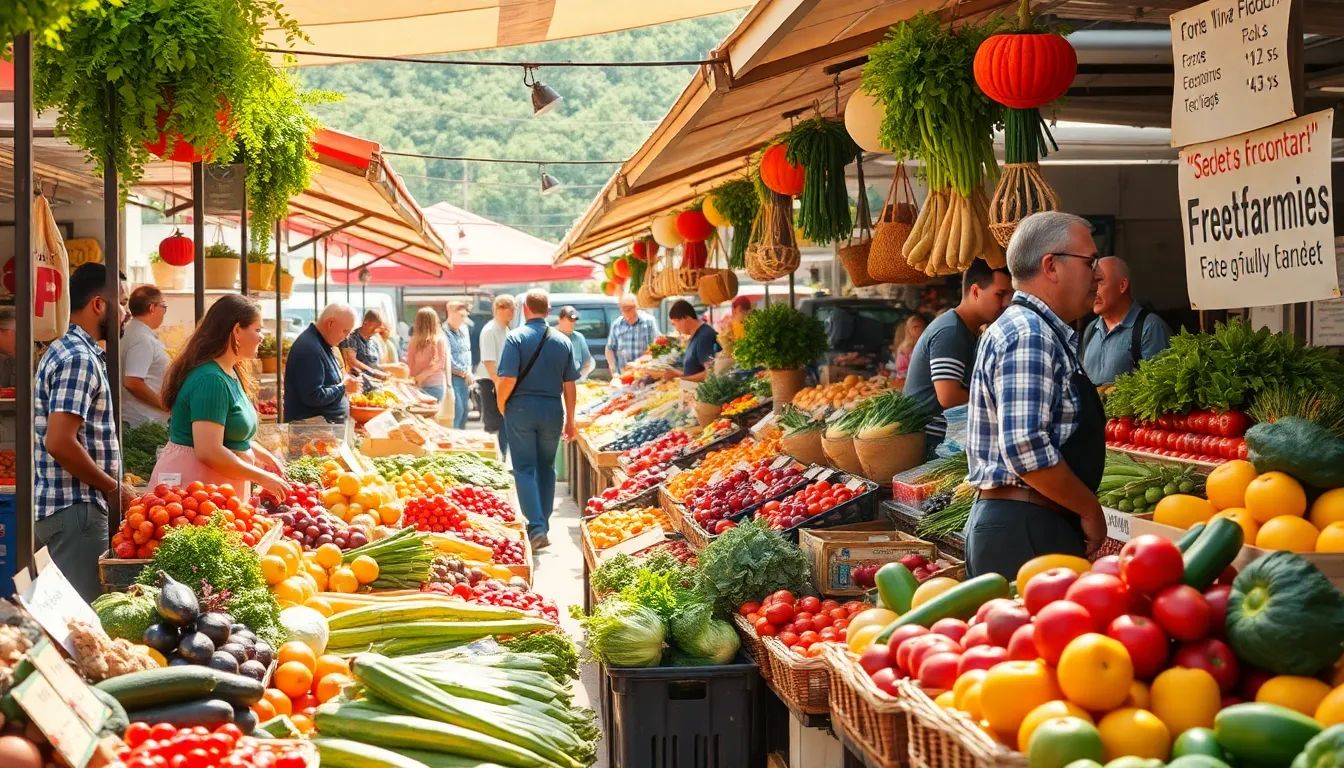Food trends come and go faster than a hot slice of pizza disappears at a party. One moment, everyone’s raving about kale smoothies, and the next, it’s all about the latest avocado toast creation that’s somehow more Instagrammable than a cat in a bowtie. Keeping up with these trends can feel like a culinary rollercoaster, but that’s what makes the food scene so exciting.
Table of Contents
ToggleOverview of Popular Food Trends
Food trends constantly evolve, reflecting societal shifts and consumer demands. Health-focused options gain traction as consumers pursue wellness, making dishes like whole grain bowls or plant-based alternatives popular. Sustainability also prompts interest in local sourcing and seasonal ingredients, encouraging chefs to innovate menus based on regional produce.
Technology influences aesthetics and dining experiences. Instagram-worthy dishes, vibrant colors, and unique presentations attract attention. Dishes like cloud bread or rainbow bagels highlight this trend, as visuals matter in food choices.
Flavor experimentation pushes boundaries. Traditional cuisines blend with modern techniques, creating fusion dishes that excite the palate. Examples include Korean tacos or sushi burritos, merging diverse culinary traditions into exciting options.
Convenience shapes how people eat. Delivery services grow, as busy schedules leave limited time for meal prep. Meal kits featuring organized ingredients simplify cooking while catering to various dietary preferences.
Cultural exploration thrives as people seek authentic experiences. Ethnic cuisines draw interest, with dishes like Ethiopian injera or Japanese ramen entering mainstream dining. This exploration fosters appreciation for cultural diversity through cuisine.
Dietary preferences impact trends significantly. Veganism, gluten-free diets, and keto lifestyles dominate discussions. Restaurants adapt menus, offering specialized options to attract health-conscious consumers.
Popular food trends showcase a dynamic culinary landscape. The intersection of health, technology, convenience, and cultural exploration shapes choices, reflecting society’s evolving taste buds and preferences.
Sustainable Eating

Sustainable eating emphasizes environmental responsibility and ethical food sourcing. This trend highlights consumer demand for healthy options that support local economies and the planet.
Plant-Based Diets
Plant-based diets gain traction as more individuals recognize their health benefits. Nutrient-rich foods like legumes, grains, fruits, and vegetables dominate these diets. Many people choose plant-based meals to reduce their environmental footprint while improving overall well-being. Research shows that adopting plant-based options can decrease greenhouse gas emissions and lower resource consumption. Restaurants increasingly create innovative plant-based dishes to attract health-conscious diners. Familiar favorites, like burgers made from beans or lentils, showcase this shift. The vibrant flavors and textures of plant-based foods capture broader audiences.
Locally Sourced Ingredients
Locally sourced ingredients play a vital role in sustainable eating. Regions benefit economically when consumers choose to buy from nearby farms and producers. Chefs focus on seasonal produce to create fresh dishes that reflect local flavors. Many menus proudly display sourcing information, connecting consumers to the origins of their food. Research indicates that local sourcing also reduces transportation emissions, enhancing sustainability efforts. Farmers’ markets become hotspots for fresh ingredients, encouraging community engagement. The movement toward local sourcing fosters a greater appreciation for the culinary landscape. As awareness grows, more restaurants prioritize partnerships with local growers for seasonal menu offerings.
Global Cuisines
Culinary diversity shapes the evolving food landscape. Global cuisines influence trends, driving appreciation for authentic flavors and innovative dishes.
Fusion Foods
Fusion foods blend culinary traditions, creating unique dining experiences. Chefs mix techniques and ingredients from various cultures to produce standout flavors. Korean barbecue tacos represent this trend through the combination of spicy kimchi and grilled meats in a familiar format. Sushi burritos offer another example, wrapping sushi ingredients in a burrito-style roll. These dishes appeal to adventurous foodies looking for novel combinations that excite the palate.
Street Food Influences
Street food influences mainstream dining, bringing vibrant flavors to upscale restaurants. High-quality versions of comfort foods like bao buns and gourmet hot dogs emerge as chefs seek inspiration from local vendors. Authenticity remains key, as these dishes capture the essence of cultural culinary practices. Food trucks contribute significantly, offering creative and diverse menu options that reflect regional tastes. Street food’s casual, vibrant nature encourages diners to explore new flavors while enjoying a relaxed atmosphere.
Health-Conscious Choices
Health-conscious choices dominate today’s food landscape. Consumers increasingly seek options that align with wellness goals, reflecting a societal push toward healthier eating habits.
Alternative Proteins
Alternative proteins gain traction as diners explore plant-based options. These proteins include legumes, tempeh, and seitan, appealing to vegan and vegetarian consumers. The rise of products like chickpea pasta and pea protein-based meat alternatives demonstrates this trend. Companies like Beyond Meat and Impossible Foods innovate to provide satisfying, meat-like textures. Chefs incorporate these alternatives into their menus, creating dishes that cater to a diverse range of dietary needs. This shift not only promotes health but also supports sustainability in food production.
Low-Carb and Keto Options
Low-carb and keto options capture attention for their weight management benefits. Consumers embrace diets that restrict carbohydrates, often leading them to prioritize healthy fats and proteins. Restaurants adapt by offering dishes like cauliflower rice bowls and zucchini noodles to accommodate these preferences. Bakeds goods made with almond flour and coconut flour replace traditional high-carb options, offering delicious alternatives. Grocers also expand their keto product lines, featuring items like low-sugar snacks and sugar-free beverages. This trend aligns with a growing focus on nutritional awareness and healthier lifestyle choices.
Technology and Food Trends
Advancements in technology significantly influence food trends, reshaping how consumers engage with culinary options.
Meal Kits and Delivery Services
Meal kits simplify cooking at home, providing pre-measured ingredients and easy-to-follow recipes. Services like Blue Apron and HelloFresh cater to busy lifestyles, helping consumers save time while enjoying home-cooked meals. Delivery services also offer convenience, allowing people to order meals from local restaurants directly through apps. Companies like DoorDash and UberEats facilitate access to diverse cuisines, making it easier for consumers to try new dishes without leaving home.
Food Apps and Social Media Influence
Food apps play a crucial role in shaping dietary choices and dining experiences. Platforms like Instagram and TikTok create trends around visually appealing dishes, encouraging users to share their culinary experiences. Chefs and food brands use these platforms to connect with audiences, fueling interest in new flavors and preparation methods. Influencers often showcase recipes and restaurant recommendations, leading to viral food trends that can quickly dominate menus. The engagement on social media platforms drives consumer curiosity and exploration of innovative dining options.
The world of food trends is a vibrant tapestry woven from health consciousness sustainability and cultural exploration. As consumers become more discerning they drive demand for innovative options that align with their values and lifestyles. Chefs and food creators are rising to the challenge crafting dishes that not only satisfy cravings but also reflect a commitment to ethical sourcing and global flavors.
With technology continuing to transform the dining experience the future of food trends promises even more excitement. As culinary boundaries blur and new tastes emerge it’s clear that the journey through the evolving food landscape will remain an enticing adventure for all food enthusiasts.

